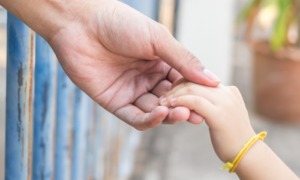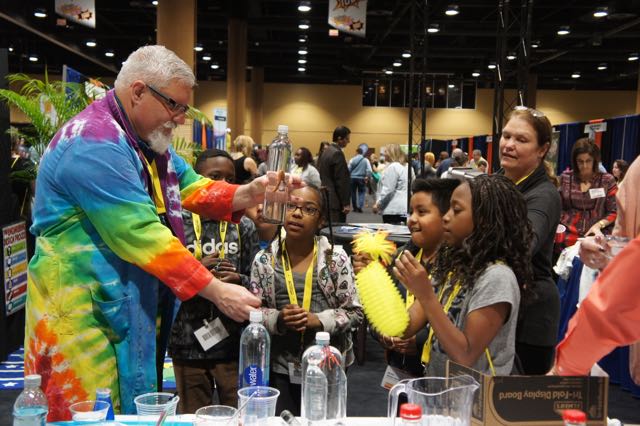
Photos by Stell Simonton
Andy Allan (in tie-dyed lab coat) wows kids with a science experiment in the exhibit hall at the National AfterSchool Association Convention in Orlando, Florida, last week.
“Our communities need us,” said Gina Warner, president and CEO of the National AfterSchool Association (NAA), in Orlando, Florida, last week, addressing approximately 1,500 after-school workers, program administrators and others at their annual convention. They were there to learn new ways to engage young people, create effective after-school programs and strengthen themselves professionally.
Floating in the air might have been echoes from another recent gathering of youth workers and educators, the National Youth-at-Risk Conference held in Savannah, Georgia, in early March.
In Savannah, educators and nonprofit staff discussed poverty, the achievement gap, mental health and the needs of minority children.
“We are segregated in America,” said Donna Beegle, a consultant and trainer who grew up in poverty and wrote the book “See Poverty, Be The Difference.”
Poverty teaches kids that no one cares about them, Beegle told the Savannah gathering, which drew more than 1,200 people.
To children in poverty, everyone seems smarter, Beegle said.
Kids think: “They must be better than me … we don’t belong … People like us don’t get educated … There is no one to help,” she said.
“Kids think they’re dumb because they don’t know middle-class stuff,” Beegle said.
She called on teachers and youth workers to show respect to children.
Human beings don’t take information from people who don’t respect them, she said. It tells them “there’s not a whole lot of hope for you.” We have to believe in our students, she said.
Schools can’t do it alone
After-school workers are on the front lines of poverty. They’re uniquely positioned to put a spotlight on the needs of children and demand action, Ralph Smith, senior vice president of the Annie E. Casey Foundation, told participants at the National AfterSchool Association Convention.
School-based education was once thought to be the path out of poverty in the United States, Smith said. “[But] there is a significant and growing number of children who are falling beyond the reach of schools,” he said. Smith is also the managing director of the Campaign for Grade-Level Reading.
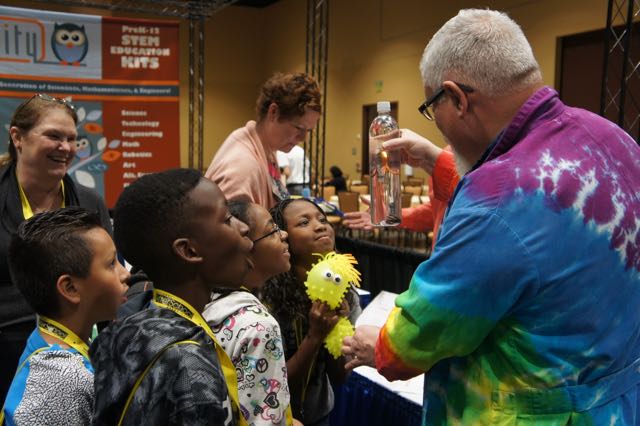
The after-school field needs to “disrupt the idea that schools can do it alone,” he said. We need a system of intervention and support, he said.
Dan Rea teaches in the College of Education at Georgia Southern University and has served as the chair for the Youth-at-Risk Conference since 1994.
“Students can be at risk from a lot of things,” Rea said. They can be risking low achievement, dropping out of school, failure in life, feeling alienated — and as a result, “that leads to all kinds of problems,” he said.
“We do use the term ‘at risk’ because we don’t want to sugarcoat the situation,” he said.
Youth are placed at risk by environmental circumstances. “It might be poverty, peer pressure, poor teaching strategies — all kinds of situations,” he said.
Both the Orlando and Savannah gatherings focused on ways to help kids academically — and especially kids in poverty.
For example, Susan Hamann and Rachel Kessler of OregonASK, the Oregon statewide after-school network, held a workshop at the NAA convention presenting a wide variety of after-school literacy materials.
Susan Schlecht, of the Florida Solar Energy Center, presented simulation games and other hands-on activities to help kids engage in science.
At the YAR conference, Robert Lynch, director of the Geneseo Migrant Center, encouraged persistent outreach to kids of migrant farm workers.
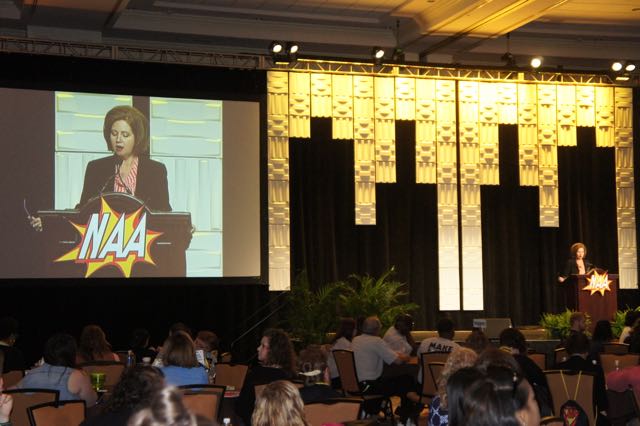
The empowerment of youth workers was emphasized at the National AfterSchool Association annual convention last week, underscored by a superhero theme. Here, Gina Warner, president and CEO, addresses the convention.
Head and heart
Both gatherings also emphasized fostering social and emotional skills.
We’re starting to recognize the importance of the heart, Rea said. There’s a need for social and emotional skills and a good social supportive school environment so students feel like they belong and are listened to.
At the NAA convention, after-school workers heard how to analyze their programs to see which social and emotional skills are being taught and how to intentionally focus on those skills.
University of Pennsylvania researcher Angela Duckworth presented her work on grit.
“Grit is both passion and perseverance,” she said, and it is a characteristic of “high-achievers.”
“If we can get kids to finish their activities” it will teach important lessons, she said. Kids need to learn to get into something and stay with it.
It was in an after-school activity that she discovered her own passion and learned to work hard, she said.
Her current research suggests that kids demonstrate and learn grit through after-school activities rather than in school. Programs should encourage kids to explore many interests, undertake deliberate and sustained practice in an interest and cultivate a sense of purpose, she said.
Don’t let kids quit on a bad day, she said.
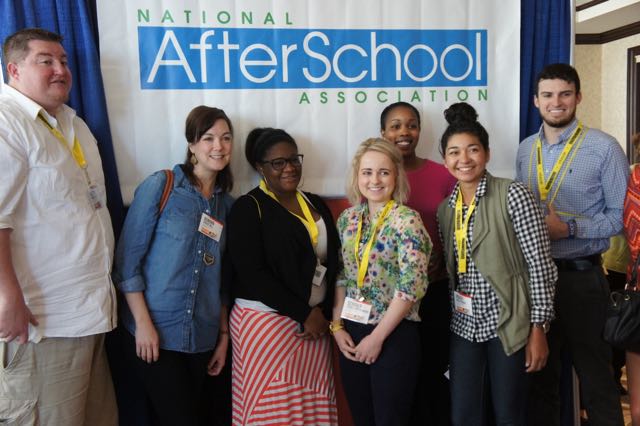
A group of after-school staff from Lawrence, Kansas, pose at the National AfterSchool Association Convention in Orlando, Florida, last week.
Both conferences focused on health and on engaging the families of children.
Eric Rowles of the consulting group Leading to Change provided several workshops at the NAA Convention geared at engaging parents and navigating “fiery” conversations with youth.
The Youth-At-Risk Conference looked at safety and violence prevention as well as promoting mental and physical health.
The National AfterSchool Association Convention looked at helping after-school workers recharge and empower themselves.
Underlying the National AfterSchool Association meeting was a sense that after-school workers, and not just kids they serve, may also be at risk. In their case, the risk is burnout related to low pay, lack of career advancement options and the low esteem in which the work is held.
When conference leaders and participants flitted around the lawn one evening, some in superhero costumes, it was a lighthearted way of sending a heavy-duty message.
The message was that the job is superimportant, workers must be recognized for the value of what they do and they must be empowered to meet the challenges of it.
Reporting from Youth-At-Risk Conference by YT Managing Editor Rachel Alterman Wallack.


